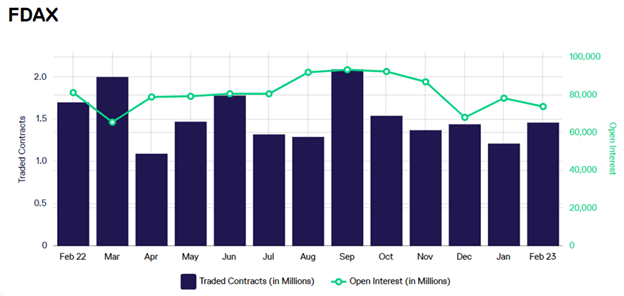The DAX® futures complex provides a unique opportunity to profit from one of the world’s most dynamic stock indexes. The Deutscher Aktienindex (DAX®) stock index is Deutsche Börse’s index of blue-chip German stocks. Launched in 1988 as an index of the top 30 stocks traded on the Frankfurt Stock Exchange, based on turnover and market capitalization, it now includes the 40 largest and most actively traded German companies. Eurex launched futures on the DAX® (FDAX) in the 1990s and more recently has added Mini-DAX® futures (FDXM) and Micro-DAX® futures (FDXS). DAX® includes such well-known stocks as Airbus SE (AIR), Adidas AG (ADS), Bayer AG (BAYN), BMW, Deutsche Bank AG (DBK), Merck (MRK), Porsche (PAH), Puma SE (PUM), Siemens AG (SIE), and Volkswagen AG (VOW). This makes it a compelling index representing the largest economy in Europe and a proxy for the Eurozone as well. With the explosion of retail trading based on the growth of electronic trading and the move towards near-24-hour trading with the introduction of E-mini futures on the S&P 500, Eurex entered the fray with futures on the DAX® and the EURO STOXX 50® indices.
Strategies for Trading DAX Futures
“The research that a trader should use before trading the DAX® futures market is the exact same that they would use to evaluate any market that they are going to trade,” says Dan Gramza, President of Gramza Capital Management, who is a trader and consultant to domestic and international clients. Gramza adds that this greatly depends on a trader’s timeframe and risk tolerance. “My suggestion would be that after you have identified your trading timeframe, begin using strategies or indicators that you are currently using in other markets. This way you have the current market performance of your trading as a basis to compare the performance of utilizing those techniques with [DAX® futures].” DAX® futures are not only a benchmark for Europe’s largest economy representing many well-known stocks but have also proven to be a reliable indicator for movements in U.S. stock indexes. Trading ahead of the U.S. open, DAX® futures are often used to predict the U.S. stock index open. This led many U.S. and global traders to trade this dynamic index instead of just using it as a market indicator. As volume and open interest continue to grow (see table), the DAX® has become one of the most liquid stock indexes in the world. [caption id="attachment_153703" align="alignnone" width="772"] Source: Eurex[/caption] However, with the success of the underlying stock index along with its volatility, the FDAX futures contract grew too large for a majority of retail traders, especially the burgeoning world of short-term day and swing traders. With an average daily range of around 200 points (often higher), the DAX® can move the equivalent of €5,000 in a day (each index point is equal to €25, see table below).
Source: Eurex[/caption] However, with the success of the underlying stock index along with its volatility, the FDAX futures contract grew too large for a majority of retail traders, especially the burgeoning world of short-term day and swing traders. With an average daily range of around 200 points (often higher), the DAX® can move the equivalent of €5,000 in a day (each index point is equal to €25, see table below).
Here are the specs for FDAX, FDXM, and FDXS:
| FDAX | FDXM | FDXS | |
|---|---|---|---|
| Quotation | Euros per index point | Euros per index point | Euros per index point |
| Trading Hours | Sunday to Friday, 7:00 pm to 4:00 pm ET | Sunday to Friday, 7:00 pm to 4:00 pm ET | Sunday to Friday, 7:00 pm to 4:00 pm ET |
| Tick Value | €25 | €5 | €1 |
| Duration | Quarterly: March, June, Sept. Dec. | Quarterly: March, June, Sept. Dec. | Quarterly: March, June, Sept. Dec. |
| Settlement | Cash | Cash | Cash |
| Close | The third Friday of the relevant month provided that such day is a trading day at Eurex; otherwise, it shall be the trading day immediately preceding. | The third Friday of the relevant month provided that such day is a trading day at Eurex; otherwise, it shall be the trading day immediately preceding. | The third Friday of the relevant month provided that such day is a trading day at Eurex; otherwise, it shall be the trading day immediately preceding. |
| Last Trading Day/ Settlement | The last trading day of the Index Futures Contracts is the third Friday of the contract month provided that it is a trading day at Eurex; otherwise, it is the trading day immediately preceding. The final settlement day is the last trading day. | The last trading day of the Index Futures Contracts is the third Friday of the contract month provided that it is a trading day at Eurex; otherwise, it is the trading day immediately preceding. The final settlement day is the last trading day. | The last trading day of the Index Futures Contracts is the third Friday of the contract month provided that it is a trading day at Eurex; otherwise, it is the trading day immediately preceding. The final settlement day is the last trading day. |
The margin requirement and risk for holding the big contract are way too high for anyone except institutional and long-term investors.
